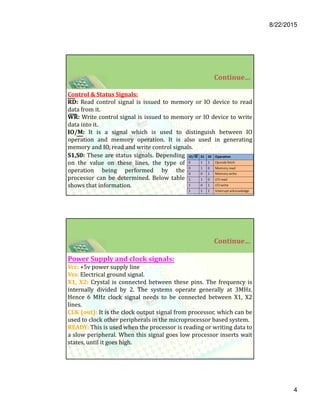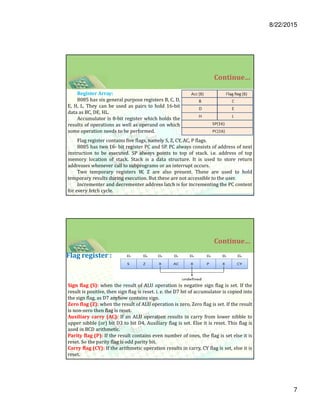8085 microprocessor Architecture and pin description
- 1. 8/22/2015 1 Intel 8085 Microprocessor Architecture, Features & Signals Introduction It is invented in 1976. It is an 8-bit microprocessor. It has 16 address lines, therefore it can access 2^16 = 64K bytes of memory. It has 8 Data lines and 16 address lines, out of which 8 address lines are multiplexed with 8 data lines. It provides one Accumulator, one Flag register, 6 General purpose registers(B, C, D, E, H and L) and two special purpose registers (PC, SP). The clock frequency of 8085 microprocessor is 3MHz. 8085 microprocessor provides on chip clock generator, therefore there is no need of external clock generator, but it requires external tuned circuit like LC, RC or crystal. It is available in 40 pin dual in line (DIP) package. It requires a +5volts of power supply.
- 2. 8/22/2015 2 Continue… It generates 8 bit I/O address, hence it can access 2^8 = 256 input ports and 256 output ports. 8085 has five hardware interrupts: TRAP, RST 5.5, RST 6.5, RST 7.5, and INTR. The hardware interrupt capability of 8085 microprocessor can be increased by providing external hardware. 8085 microprocessor has capability to share its bus with external bus controller (Direct Memory Access controller); for transferring large amount of data from memory to I/O and vice versa. It provides two serial I/O lines which are SOD and SID; it means, serial peripherals can be interfaced with 8085 microprocessor directly. Pin diagram of 8085 Microprocessor
- 3. 8/22/2015 3 Pin Details of 8085 Microprocessor Address & data lines: Address bus: 8085 has 16-bit address bus AD0-AD7 and A8-A15. In this lower address bus is multiplexed with data bus. A8-A15 lines are unidirectional and AD0-AD7 lines are bidirectional. Data bus: AD7-AD0 is 8-bit bidirectional data bus. It is multiplexed with lower order address bus. ALE: Address latch enable. It is used to de-multiplex AD0-AD7. It is connected to strobe input of latch which is used to separate address and data bus lines. It is issued in first T-state. Address & data lines: Address bus: 8085 has 16-bit address bus AD0-AD7 and A8-A15. In this lower address bus is multiplexed with data bus. A8-A15 lines are unidirectional and AD0-AD7 lines are bidirectional. Data bus: AD7-AD0 is 8-bit bidirectional data bus. It is multiplexed with lower order address bus. ALE: Address latch enable. It is used to de-multiplex AD0-AD7. It is connected to strobe input of latch which is used to separate address and data bus lines. It is issued in first T-state. Continue…
- 4. 8/22/2015 4 Control & Status Signals: RD: Read control signal is issued to memory or IO device to read data from it. WR: Write control signal is issued to memory or IO device to write data into it. IO/M: It is a signal which is used to distinguish between IO operation and memory operation. It is also used in generating memory and IO, read and write control signals. Continue… S1,S0: These are status signals. Depending on the value on these lines, the type of operation being performed by the processor can be determined. Below table shows that information. Continue… Power Supply and clock signals: Vcc: +5v power supply line Vss: Electrical ground signal. X1, X2: Crystal is connected between these pins. The frequency is internally divided by 2. The systems operate generally at 3MHz. Hence 6 MHz clock signal needs to be connected between X1, X2 lines. CLK (out): It is the clock output signal from processor, which can be used to clock other peripherals in the microprocessor based system. READY: This is used when the processor is reading or writing data to a slow peripheral. When this signal goes low processor inserts wait states, until it goes high.
- 5. 8/22/2015 5 Continue… Reset Signals: RESET IN: When low signal is applied on this pin, 8085 resets and the microprocessor boots from 0000h location in memory i.e. PC is loaded with 0000h location. RESET OUT: When processor is reset, this signal goes high. This pin is connected to reset input of other peripherals. So when processor is reset, other peripherals are also reset. Serial IO lines: SID: serial input data, used to receive serial data. SOD: serial output data, used to send serial data Continue… Interrupt Signals: INTR: interrupt request is general purpose interrupt signal. The interrupting device needs to send the vector address also. INTA : is interrupt acknowledging signal. This signal indicates that processor has accepted the interrupt. RST7.5, RST6.5, RST5.5: These are external vectored interrupts. When these interrupt occurs, processor vectors to a specific location. TRAP: It is a non-mask able interrupt. DMA signals: HOLD: This line is used by DMA controller to request microprocessor for system bus. When this line goes high microprocessor completes its current bus cycle and issues system bus to DMA controller. HLDA: HOLD acknowledging signal. Processor acknowledges DMA request using this signal.
- 6. 8/22/2015 6 Architecture of 8085 Microprocessor Fig:- Architecture of 8085 microprocessor Continue… The following are the different blocks in the 8085 processor. ALU: It is 8-bit ALU. It can perform arithmetic and logical operations on 8-bit data. If an operation needs to be performed on 16-bit data, it needs to be broken into two 8-bit parts and each 8-bit operation should be performed on each 8-bit data. It takes operand inputs from accumulator and a temporary register. Result of the operation is stored in accumulator. Depending on the result of operation, flags in flag register values will be changed. Accumulator It is a 8-bit register which is used to perform airthmetical and logical operation. It stores the output of any operation. It also works as registers for i/o accesses. Temporary Register It is a 8-bit register which is used to hold the data on which the acumulator is computing operation. It is also called as operand register because it provides operands to ALU.
- 7. 8/22/2015 7 Continue… Flag register contains five flags, namely S, Z, CY, AC, P flags. 8085 has two 16- bit register PC and SP. PC always consists of address of next instruction to be executed. SP always points to top of stack. i.e. address of top memory location of stack. Stack is a data structure. It is used to store return addresses whenever call to subprograms or an interrupt occurs. Two temporary registers W, Z are also present. These are used to hold temporary results during execution. But these are not accessible to the user. Incrementer and decrementer address latch is for incrementing the PC content for every fetch cycle. Register Array: 8085 has six general purpose registers B, C, D, E, H, L. They can be used as pairs to hold 16-bit data as BC, DE, HL. Accumulator is 8-bit register which holds the results of operations as well as operand on which some operation needs to be performed. Continue… Sign flag (S): when the result of ALU operation is negative sign flag is set. If the result is positive, then sign flag is reset. i. e. the D7 bit of accumulator is copied into the sign flag, as D7 anyhow contains sign. Zero flag (Z): when the result of ALU operation is zero, Zero flag is set. If the result is non-zero then flag is reset. Auxiliary carry (AC): If an ALU operation results in carry from lower nibble to upper nibble (or) bit D3 to bit D4, Auxiliary flag is set. Else it is reset. This flag is used in BCD arithmetic. Parity flag (P): If the result contains even number of ones, the flag is set else it is reset. So the parity flag is odd parity bit. Carry flag (CY): If the arithmetic operation results in carry, CY flag is set, else it is reset. Flag register :
- 8. 8/22/2015 8 Continue… Instruction Register and Decoding: Instruction register holds instruction that is fetched from memory. Instruction decoder decodes the opcode (which is part of fetched instruction present in instruction register). Instruction register is not accessible to the programmer. Interrupt Controller: 8085 has 5 external interrupts. TRAP, INTR, RST 5.5, RST 6.5, and RST 7.5. Whenever processor gets interrupt it finishes current instruction execution and issues INTA (interrupt acknowledge) signal to the peripheral which raised the interrupt and goes to execute interrupt service routine. Interrupt controller controls the interrupts. Serial I/O control: Serial data can be sent out using SOD pin and serial data can be read from SID pin. It controls serial IO related operations. Program Counter It is a 16 bit register used as memory pointer. It stores the memory address of the next instruction to be executed. So we can say that this register is used to sequencing the program. Generally the memory has 16 bit addresses so that it has 16 bit memory. The program counter is set to 0000H. Continue… Stack Pointer It is also a 16 bit register used as memory pointer. It points to the memory location called stack. Generally stack is a reserved portion of memory where information can be stores or taken back together. Timing and Control Unit It provides timing and control signal to the microprocessor to perform the various operation. It has three control signal. It controls all external and internal circuits. It operates with reference to clock signal. It synchronizes all the data transfers. There are three control signal: ALE- Arithmetic Latch Enable, It provides control signal to synchronize the components of microprocessor. RD- This is active low used for reading operation. WR-This is active low used for writing operation. There are three status signal used in microprocessor S0, S1 and IO/M. It changes its status according the provided input to these pins.
- 9. 8/22/2015 9 Thank You Have a Nice Day









